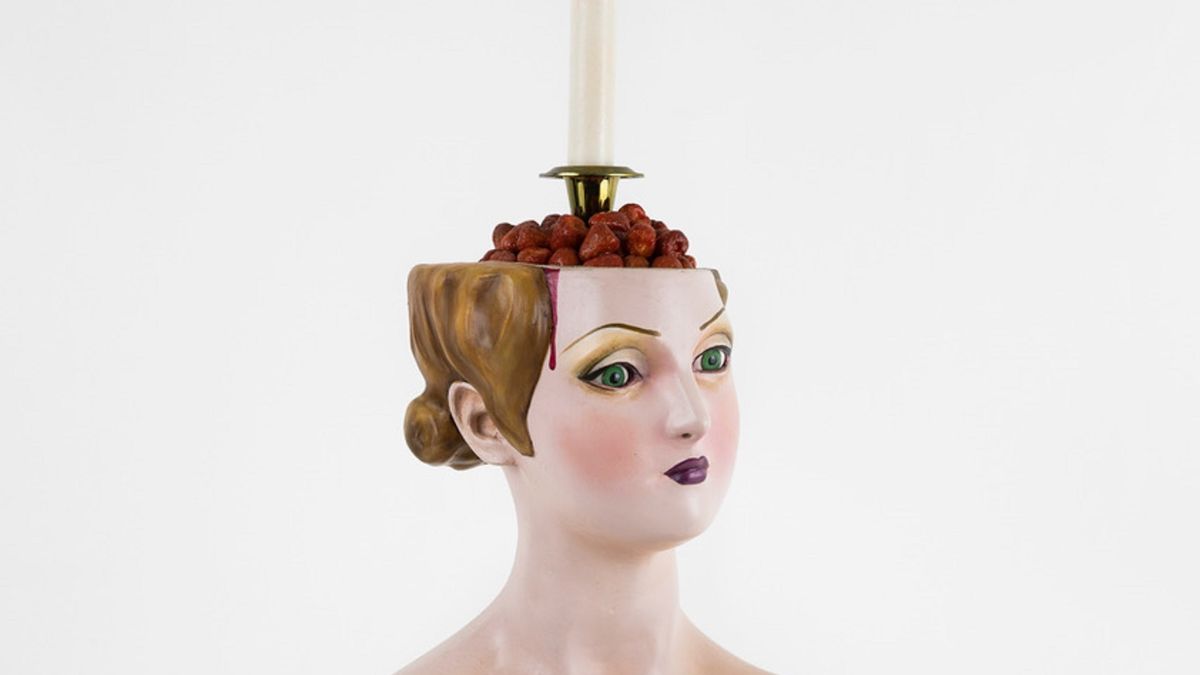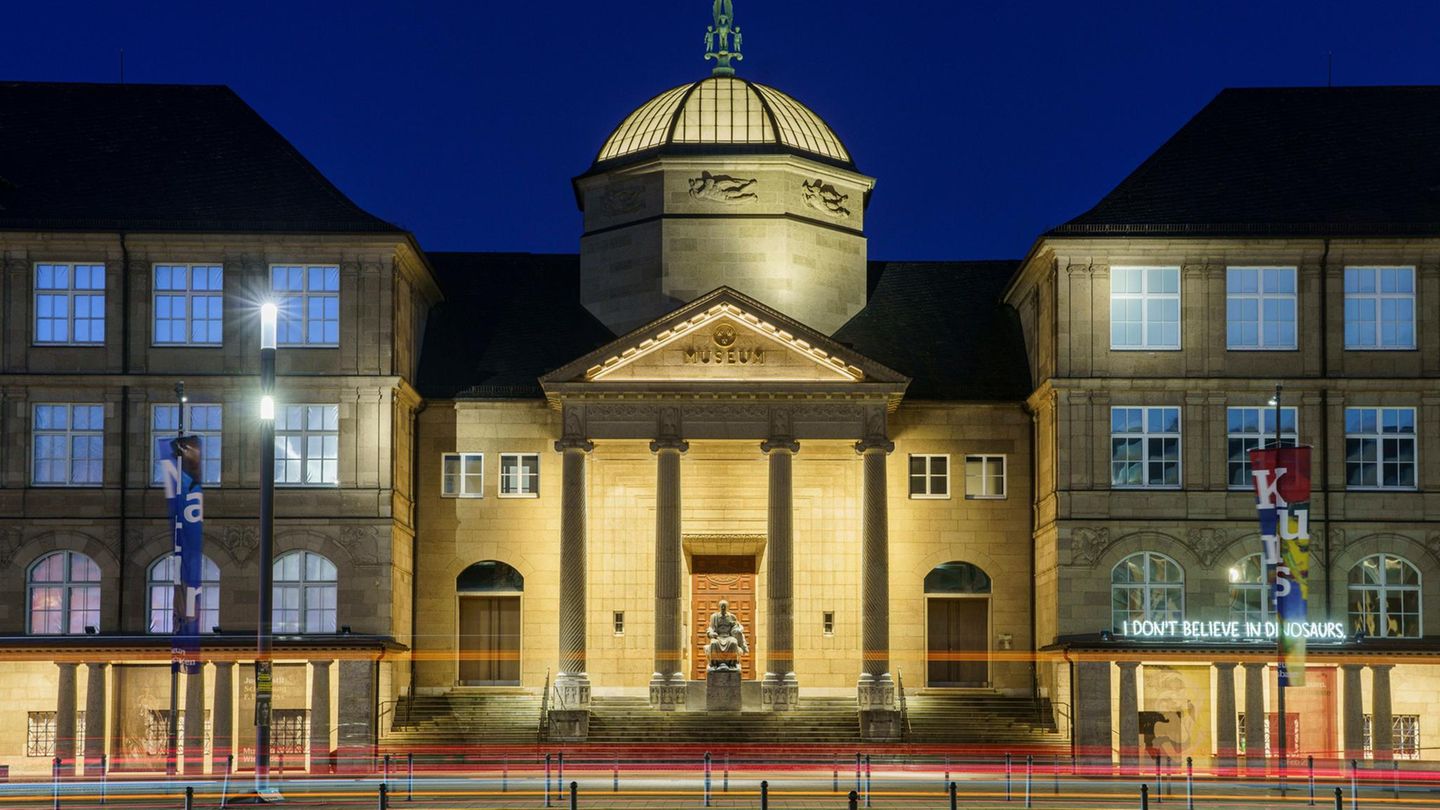The cosmocosa gallery presents the exhibition “Family furniture”Of the artist Alfredo Rodríguez Arias (1944). Consecrated in the world as theater director, Arias It belongs to the group of artists of the Torcuato Di Tella Institute that still remains active. Today, his works bring to the present the radiant expressiveness of the 60s, the aesthetic seduction and the direct language of pop, intense colors, bright material and lapidary simplicity that conquers the viewer’s gaze.
The stimulant climate of Di Tella and that of the theaters of Paris, a city where Arias It settled since the 70s, when the revolutionary directed “Evita” of CopiThey survive next to the pop qualities that were not placed over time. Before admission to the Cosmocosa room, two candlesticks are exhibited that combine the attractive beauty of two female faces with Deco features and their sinister characteristics.
To begin with, the upper part of the skull is cut and from that hole protrudes crowned by a burning candle. The sculpture deserves to be a detail, the cutting of the skull reveals the perfect tracing of bone matter, its somewhat grayish ivory tone and the porous condition of the bone. While the candle melts on the strawberries, the wax acquires the red color of the blood and slides through the woman’s temple.
Upon entering the room, several works inspired by Alfred Hitchcock’s cinema are highlighted on two shelves. The cinema genius was a good art collector, and although they say he had a false Picasso, he was a admirer of Dalí, Dante Gabriel Rossetti, Max Ernst, Magritte, Giorgio de Chirico, Hopper, Klee, Rodin, Munch And, among others, Man Ray. In 2001, Pompidou exposed “Hitchcock and art: fatal coincidences”exhibition based on a solid investigation that undoubtedly caught the attention of the artist, director, actor and Argentine playwright. In Cosmocosa is the hand with the cigarette and fried egg present in “To catch the thief”, a 1955 film with the unforgettable Cary Grant and Grace Kelly, in addition to the scissors and telephone number of the phone of the “Perfect crime”also with Grace Kelly.
Among the nuclei of the sample of Arias performed entirely last year, Figure National Identity. “The Holy Family”, He holds again the cut skull of the parents stuffed with sweets, ice cream, fruits, masitas and pacifiers; the baby who accompanies them, an old loza doll with glass eyes, has its entire head, but on it a huge pacifier rests. The characters modeled with cold porcelain smile and seem to posse leather, but the misleading and perfect finish is a product of cold porcelain, dominant material throughout the exhibition. “Without template” And the woman, “High taco”.
A series of school desks talk about “Nostalgia for lost Argentina” what begins, like the national anthem, with “Oida mortal” and an immense climbing also porcelain. Arias Mix his humor with a cynicism similar to that he discovers in today’s society. In this way, on one of the banks it mounted a replica of the typical buffer with a loin whose perceptible format represents the map of Argentina, also similar to that of South America. The work is called “Geography”.
A set of masses and cakes brings to the present its sympathy for the cook Petrona C. de Gandulfo that literally sweetened his childhood. A few years ago, at the Proa Foundation he presented together with Juan Stoppani, “Patria Petrona”. He said then that his goal was to honor the memory, “The ability of each of us to reconstitute the landscape where we grew up, that place where words, gestures, perfumes, images will be forever engraved and will be part of our person. They will define our perception of the adult world. The homeland is the land that made us; in that territory they live fairy and ghosts. Petrona is one of those characters of the country”
About the sheets of the kitchen books of the kitchen teacher, he says: “They are just images. I never tried a dish prepared by Petrona, everything was television transmission, waves and interpretations of those recipes.”
(…) “The house where I looked at Doña Petrona’s programs was located in climbing remedies. There, in front of the American villa that my father had built, there was a cataclysm: the government decided to expropriate the neighboring houses to make a waist path pass, or a general peace, or a Pan -American that never happened. In that desert And silent to the workshop club, a great pasture for the ghosts where the Doña cooked. “
“When Perón gave his speeches,” he said, “the people of the town asked us to watch television; my parents approached the device to the window and behind the bars the colonel was governing her faithful. It was a mass. In that same device a petrona day appeared: for me it was a shelter; instead of going to Disneyland, I went to Petronaland, and every time my parents fought (they fought (they fought (they fought (they fought Making a dish, preferably a Petrona dessert, to evade those Petrona’s desserts that I prepared were always a failure. Which parents deposited all hopes where those fantastic fascinations should finally be erased and thus lightened, well stopped and with my head well cleared, I could face the future that awaited me. Tortazo is not a historical or sociological work, it is just a poetic planning of memory. A Twist Again“.
Finally, behind a black curtain, in a dark room, the spectator can observe with a flashlight, two faced and tabicate works as in the episodes of the comic, where the characters of “the construction of the real” are found. There they tell the story of two sisters who end up pregnant, deceived by a genuine “Farabute”, according to the text they deliver in the gallery. The encounter with an art that stylistically refers to the past is based on the connotations that adds the present and aesthetic pleasure.
Di Tella was a center where Arias’s inventiveness was developed and a group of talented artists. At the headquarters of Florida Street, facilities, happenings, participatory works and experimental shows that frequently scandal the public were multiplied. In the ITDT, works such as “Dracula” (1966), “Futura” (1967) and “Adventure” (1968). In the brilliant career of Arias The recreation of classic texts stands out, such as “The blue bird” of Maeterlinck, “The Tempest”of Shakespeare either “The maids”of Genetadded to the powerful personal experiences “Mortadela”, “Fausto Argentino”, “Mambo mystical”among others.
Source: Ambito
I am an author and journalist who has worked in the entertainment industry for over a decade. I currently work as a news editor at a major news website, and my focus is on covering the latest trends in entertainment. I also write occasional pieces for other outlets, and have authored two books about the entertainment industry.




